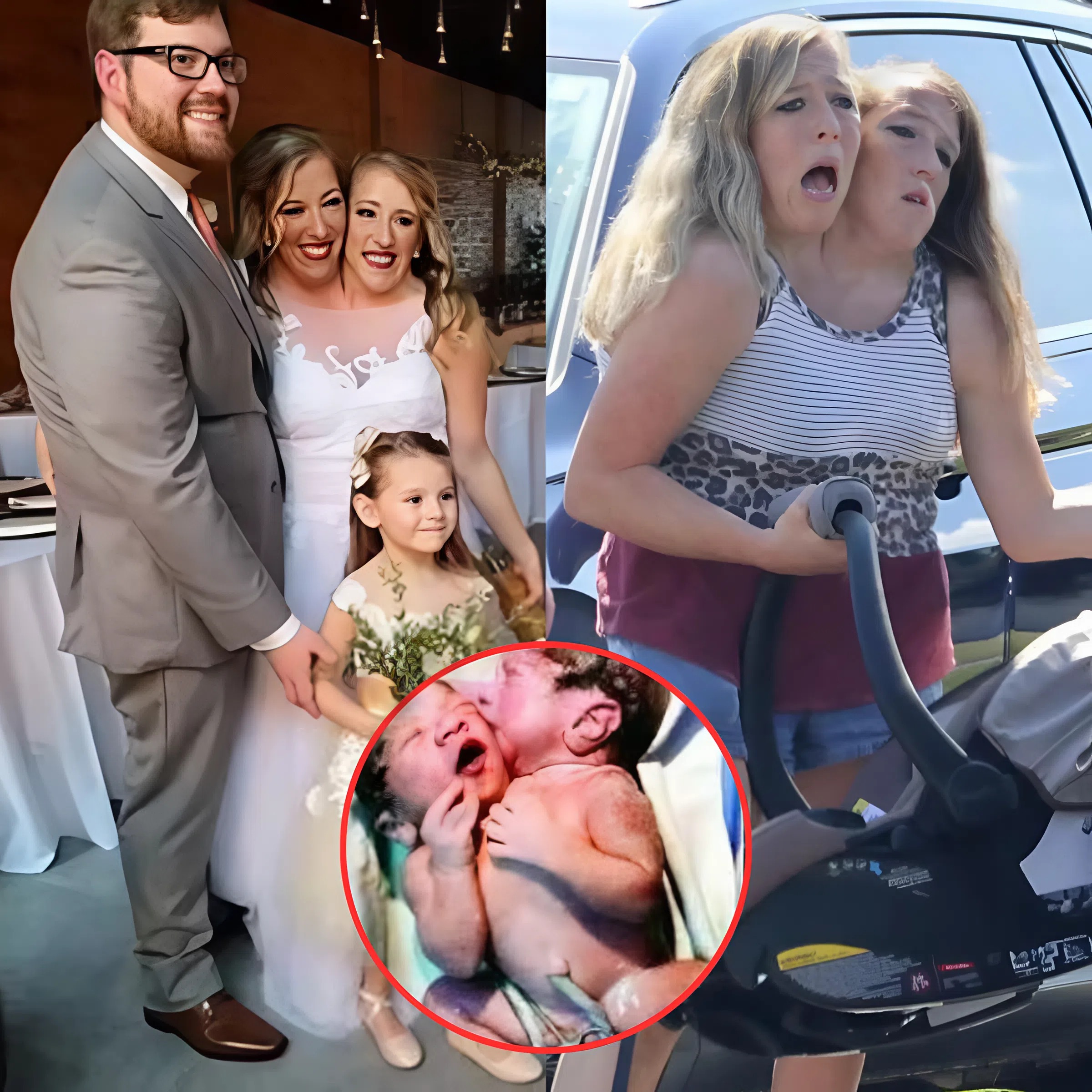When a single photo can ignite a worldwide conversation, few moments capture the public imagination like this one. The image — Abby and Brittany Hensel, the world’s most well-known conjoined twins, smiling as they cradle a newborn — ricocheted across social media platforms in a matter of hours. It wasn’t just another feel-good viral post. It was a cultural phenomenon, one that reignited decades-old fascination with two women who have lived their lives defying biology, society, and expectation.
Within hours, questions flooded the internet: Did they have a baby? Can they even get pregnant? How does it work?
The inquiries ranged from sincere wonder to morbid curiosity. But beneath the chaos of speculation lies a deeper story — one about biology, ethics, and what it really means to share a life, body, and future.

The Extraordinary Lives That Began as a Medical Miracle
Born on March 7, 1990, in Minnesota, Abby and Brittany Hensel entered the world as medical rarities — dicephalic parapagus twins, meaning they share a single torso and set of organs below the waist but have separate heads, spines, and hearts. Their condition is so rare that only a handful of such cases have been recorded in medical history, and even fewer have survived infancy.
Doctors initially warned their parents that survival was unlikely. Yet from the beginning, the twins defied every prediction. Over the years, they learned to coordinate every movement — walking, swimming, even driving — with perfect, wordless synchronization. Each controls one half of their shared body: Abby the right side, Brittany the left.
Their story became global when they appeared on The Oprah Winfrey Show and later starred in a TLC reality series simply titled Abby & Brittany. The world watched as they graduated from college, became teachers, and built a life that, while unconventional, was unmistakably full of joy, humor, and independence.
So when that photo surfaced — the two of them holding a baby wrapped in white — the reaction was explosive. Because this time, the world wasn’t marveling at their coordination or accomplishments. It was confronting a question many had never dared to ask: Can conjoined twins experience motherhood?
Inside the Science: How Could It Work?
To understand the possibility, one must understand the anatomy. Abby and Brittany share one body below the waist — meaning one reproductive system, one uterus, and one set of reproductive organs.

“Biologically speaking,” says Dr. Rebecca Nguyen, a board-certified OB-GYN who specializes in complex reproductive anatomy, “that means conception and pregnancy would be possible for them as a unit — not as two individuals, but as one shared body experiencing a single pregnancy.”
In simpler terms, the fetus would develop within one shared womb. But the pregnancy would affect both women equally. “They would both experience the hormonal changes, morning sickness, cravings, fatigue, and physical transformation,” Dr. Nguyen explains. “Their bodies are deeply intertwined; what happens to one happens to both.”
A pregnancy in such a situation would be classified as extraordinarily high-risk. There are several major medical challenges:
- Cardiac strain: The twins each have a separate heart, but pregnancy dramatically increases cardiovascular demand.
- Respiratory function: Shared lungs or chest space could complicate breathing as the pregnancy progresses.
- Circulatory dynamics: Since the twins share a single circulatory system below the diaphragm, managing blood flow to a growing fetus would be uniquely complex.
- Delivery: Vaginal birth would likely be impossible. A cesarean section, carefully tailored to their anatomy, would be the only viable option.
Still, Dr. Nguyen stresses that while theoretically possible, “it would require constant medical supervision, likely in a specialized hospital setting. Every aspect of care would need to be customized for their physiology.”
Love, Intimacy, and Consent in a Shared Body
Beyond the medical dimension lies a much more intimate one — the emotional and ethical complexities of love and relationships. The Hensels have always maintained that they are two distinct individuals: two personalities, two sets of dreams, two emotional lives. Yet they share a body.

So how do relationships work? “It’s deeply personal,” says Dr. Nguyen. “Romantic and sexual relationships are possible, but they demand a level of understanding and consent that’s far beyond what most of us ever consider.”
In 2021, reports circulated that Abby Hensel married an army veteran named Josh Bowling, a man who had appeared in a few family photos on social media. The twins never publicly commented on the story, choosing to maintain their privacy. But when this new baby photo emerged, speculation reignited — many assuming that Abby, perhaps as part of a married couple, might have become a mother.
If that’s true, it would mark an unprecedented moment — the first known case of dicephalic conjoined twins giving birth. Yet even if it’s not, the mere possibility exposes how little society understands about bodies that don’t fit conventional definitions.
“It’s uncomfortable for people,” Dr. Nguyen says, “because we’re used to binary categories: one body, one person. The Hensels force us to expand that idea.”
What the Viral Photo Says About Us
Within hours of the photo spreading, hashtags like #AbbyAndBrittanyBaby and #MiracleTwins trended across X (formerly Twitter) and TikTok. Some users expressed awe and joy, calling the moment “proof of human resilience.” Others, however, flooded comment sections with invasive questions or crude jokes — a reminder that public fascination often borders on voyeurism.
“It’s heartbreaking but predictable,” says Dr. Elena Torres, a sociologist who studies media ethics and disability representation. “We treat difference as spectacle. When people see something that challenges their understanding of humanity, they either romanticize it or ridicule it. Rarely do they pause to respect it.”
The Hensel twins have spent their entire lives balancing openness with privacy. They’ve shared enough of their journey to educate and inspire but have also drawn clear boundaries — particularly around intimacy and reproduction. “We don’t mind teaching people,” Brittany once said, “but we also want to live our lives, not explain them.”
Their story — and the renewed attention it’s now receiving — highlights a profound cultural tension: society’s need to consume difference versus its ability to respect it.

Could They Really Have a Child? The Expert Verdict
So, can Abby and Brittany Hensel have a child?
Dr. Nguyen’s answer is careful, nuanced, and grounded in science:
“Yes — biologically, it’s possible. But it would be one of the rarest and riskiest pregnancies in medical history.”
She emphasizes that such a pregnancy would require extraordinary care — a team of obstetricians, cardiologists, and surgeons working together from conception to delivery. “We would be navigating uncharted territory,” she says. “There’s no medical precedent to rely on for twins with this anatomy.”
Even more extraordinary, Dr. Nguyen adds, is the psychological component. “Pregnancy changes a person’s sense of self. For conjoined twins, it would mean two minds sharing one profoundly transformative experience. That’s not just medicine — that’s philosophy.”
The Larger Meaning: Redefining Humanity and Wholeness
Perhaps the real reason the world can’t look away isn’t the medical mystery but the emotional symbolism. Abby and Brittany’s lives have always challenged the definition of normal. They are two people in one body — yet fully individual in mind, heart, and spirit.
They’ve taught children, traveled the world, and lived with humor and grace despite constant scrutiny. They’ve shown that autonomy isn’t defined by physical separation but by mutual respect and cooperation.
“Their existence forces us to confront how narrow our ideas of personhood are,” says Dr. Torres. “They prove that individuality can coexist with shared identity — that unity doesn’t erase selfhood.”
In a world obsessed with division, the Hensel twins embody something profoundly healing: coexistence without conflict. Their every movement — synchronized yet separate — is a quiet metaphor for what humanity could be at its best.
The Truth Behind the Photo
So, was the baby in that photo their child? No official confirmation exists. It might be a niece, a student’s baby, or simply a family friend’s newborn. But in a way, that detail doesn’t matter.
Because whether or not Abby and Brittany are mothers, they’ve already given the world something rarer than any biological miracle — a living example of what it means to share life completely and courageously.
They’ve taught us that human connection isn’t just metaphorical; in their case, it’s literal. And yet, they’ve proven that individuality and unity can coexist beautifully within one extraordinary body.
As one viral comment perfectly captured:
“Maybe they didn’t just share a body — maybe they’ve shared a lesson with all of us: that love, respect, and resilience can transcend even the boundaries of biology.”
And in that sense, whether they have a baby or not, Abby and Brittany Hensel have already given birth — to a new understanding of humanity itself.



